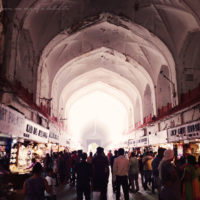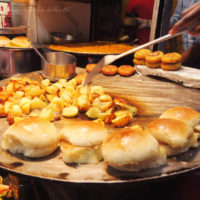Delhi as we know today from the great Indian epic Mahabharata was the site of Indraprastha, the glorious capital of the Pandavas. Today it falls under the colossal Purana Qila complex built by the Mughal emperor Humayun in the medieval times. Before the Muslim invasion Delhi was the seat of Tomaras who under their ruler Anangapala established the Lal Kot citadel in present day Mehrauli area. He also commissioned the construction of a step-well. Not a lot has survived from these time-periods.
The demeanour and culture of Delhi was deeply affected with the Muslim invasion in the 13th century. Qutub-ud-din-Aibak the first sultan of Delhi arrived from central Asia. His rule brought Islamic architecture and culture to India leading to the construction of some Indo-Islamic monuments in Delhi like the Qutub Minar and the Quwwat-ul-Islam mosque which exhibit several elements of Hindu and Jaina architecture. With the Delhi Sultanate Urdu language also began penetrating the society, making Delhi cosmopolitan. The later dynasties of Delhi Sultanate- established their capital around Delhi. The Khaljis established the Hauz Khas which was further developed by Feroz Shah Tughlaq. The complex saw the development of madarsas and tomb around the Hauz Khas lake in readily available Delhi quartzite. This complex also reveals an amalgamation of Hindu and Islamic elements in architecture. The Tughlaqabad fort and Lodi garden also evolved during the sultanate period under the Tughlaqa’s and Lodi’s respectively bringing the concept of arches and domes to India. By the end of the Delhi Sultanate the Islamic architecture and culture made a strong hold in Delhi.
The Mughals succeeded the Delhi Sultanate. Descending from a Turcko-Mongol family, Babur became the first Mughal emperor. His lineage made great contributions to India in terms of art, architecture, painting, food and language. The Purana Qila complex earlier known as Dinpanah citadel was initiated by Humayun, the son of Babur. One of the earliest forts of Delhi, it boasts a balanced use of Indian and Islamic elements in its architecture. The generous use of Red sandstone along with white and black marble inlay and glazed tiles are the highlights of this complex. The greatest achievements of the Mughals was the Humayun’s tomb. Strategically positioned close to the Purana Qila and the holy shrine of Nizam-ud-din Auliya, the tomb is a precursor of the fully developed Mughal architecture seen at Agra. It manifests a balanced use of red sandstone with black and white marble inlay and chhatris (pillared kiosks) decorated with coloured tiles. The tomb also depicts the concept of “char-bhag”- a Persian and Islamic quadrilateral garden synonymous to the four gardens of paradise mentioned in the Quran. Shah Jahan commissioned the red fort in his capital Shahjahanabad. Presently the old Delhi area, Shahjahanabad with all its hustle-bustle is the soul of Delhi.
Besides art and architecture, language also underwent changes. Persian, Urdu, Arabic and Turkish became a part of the repertoire. In fact holy verses in Persian and Arabic were carved on their monuments. The vibrant literary culture disseminated in Delhi and had a strong hold until the 1857. It still survives today at universities and academic centres but sporadically. The rich and luxurious Mughal cuisine also percolated the society of Delhi and remains an important part Delhi’s food culture. The architecture, lifestyle and culture of Mughals and their Islamic precursors were retained to a greater extent so much so that if one visits the lanes of old Delhi, the medieval traditions comes to life with their old havelis, street foods and bazaars. Moreover, the prayers and Qawwalis offered in the Nizam-ud-din dargah reminds of the old Islamic traditions. The prayers at Hindu shrines and gurudwaras co-exist along with the attractive night life of New Delhi.
Thus, the contemporary Delhi is an amalgamation of the various Hindu and Islamic cultures that evolved over the centuries. Because of its rich historical past Delhi has always attracted people from all over the world- be its mysticism, spiritualism or liveliness. Also known as “the city of Djinns” by William Dalrymple Delhi has a lot to offer in terms of mystic experiences like the abandoned Tughlaqabad fort, the mutiny memorial and many others. For spiritual experience the best that Delhi offers is the medieval dargah of Saint Nizam-ud-din Auliya. The liveliness of Delhi comes to light at the old and crowded bazaars of old Delhi as well as the night life of the city witnessed at Hauz Khas, Connaught Place and others.
Give us a chance to help you find the best counsel and idyllic surroundings and we will prepare a walk that exposes you to the cultural enigma of Delhi and leaves you wanting for more.
We are expert in walking tours and we’ve earned a solid reputation for our passion, enthusiasm and importantly, our sense of showcasing the character of the city.
We operate under the umbrella brand INDIA CITY WALKS and our selection of walks offer spectacular city experiences in Delhi and across India.
Feel free to contact us in order to find out which itinerary suits you best. You can reach us through email share@delhiwalks.in during weekends and holidays or fill the contact form.
We are passionate about travel and love to talk about it with you!






